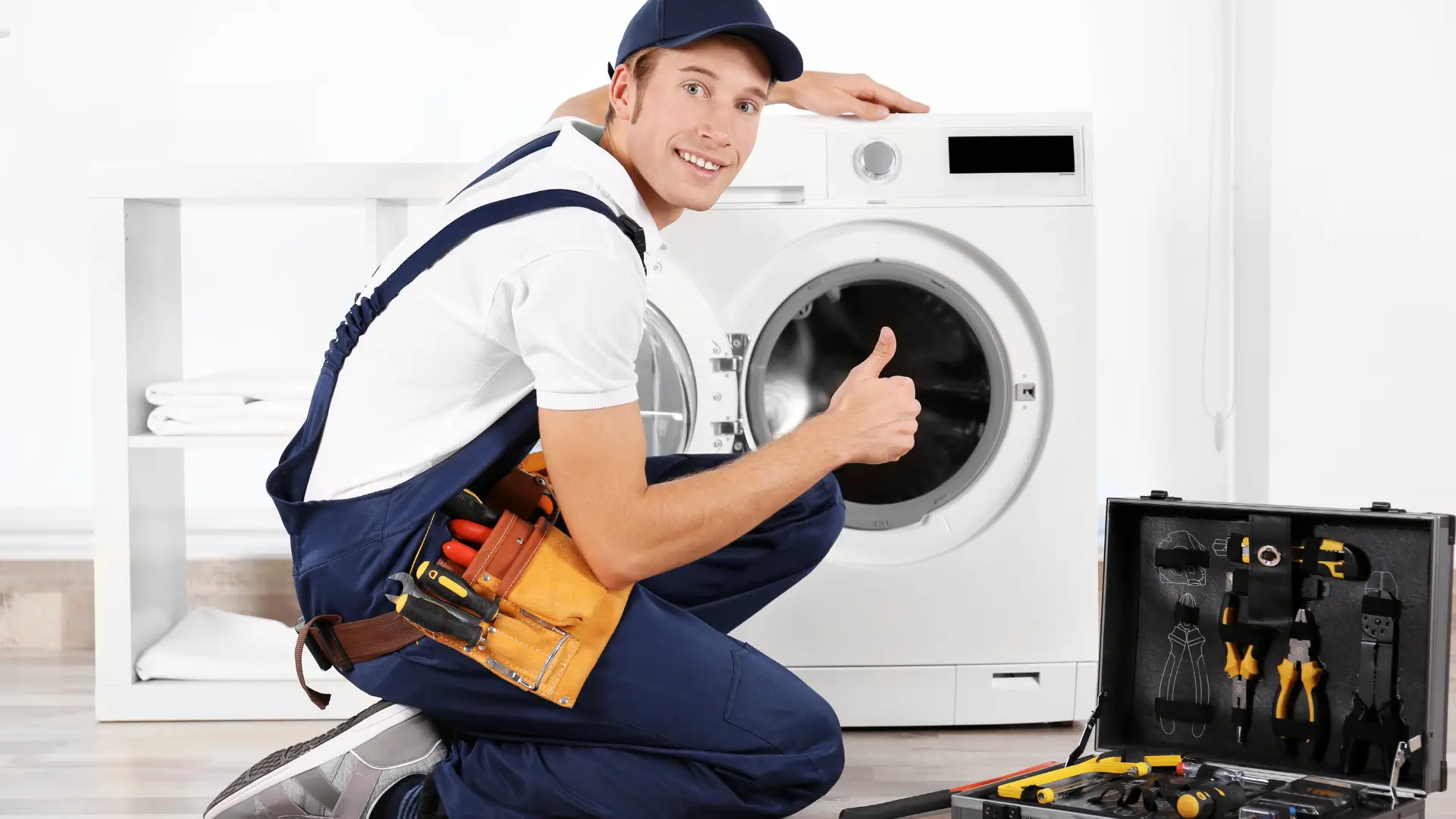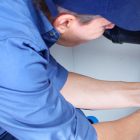A washing machine leaking can be frustrating and often catches homeowners off guard. Water pools around the base, causing damage to the floor and creating a mess. But why does this happen, and more importantly, how can you fix it? In this comprehensive guide, we’ll explore the most common reasons why your washing machine is leaking, how to diagnose the problem, and what steps you can take to resolve it. Let’s get to the bottom of this, starting with the most frequent culprits behind a washing machine leaking.
Contents
- 1 1. Leaking From the Front: Door Seal Issues
- 2 2. Leaking From the Bottom: Clogged Drainage System
- 3 3. Leaking From the Back: Loose or Damaged Hoses
- 4 4. Washing Machine Leaking During the Spin Cycle: Overloading the Machine
- 5 5. Leaking From Underneath: Internal Pump or Tub Problems
- 6 Final Thoughts on Washing Machine Leaking
1. Leaking From the Front: Door Seal Issues
If you have a front-loading washing machine, one of the most common reasons for leaks is a faulty door seal. The rubber gasket that lines the door can degrade over time, leading to leaks, especially during the washing and spinning cycles.
Why does the door seal leak?
The rubber seal on the front of your washing machine can crack, tear, or simply wear down due to frequent use. Detergent build-up, dirt, or even small foreign objects caught in the seal can prevent it from creating a watertight closure. When this happens, water starts to seep out, especially when the machine is under pressure from the spinning cycle.
How to fix it:
- Inspect the door seal: Carefully check the door gasket for signs of wear or damage. If you spot any cracks or tears, it’s time for a replacement.
- Clean the seal: Sometimes, a simple cleaning can do the trick. Using a damp cloth, wipe down the seal and remove any dirt or detergent residue. For stubborn grime, a mixture of vinegar and water can be very effective.
- Replace the gasket: If the damage is beyond repair, you’ll need to replace the gasket entirely. This can be a DIY job if you’re handy, or you can call a technician for assistance.
If the issue persists, consider calling a professional at +971545356777 to take a closer look.
2. Leaking From the Bottom: Clogged Drainage System
One of the less obvious but equally frustrating causes of a washing machine leaking is a clogged drainage system. If the water isn’t draining properly, it may overflow and leak from the bottom of the machine.
Why does this happen?
Over time, lint, small articles of clothing, or debris can get trapped in the washing machine’s drainage system. This can block the water from properly draining after each cycle, forcing it to leak out of the bottom.
How to fix it:
- Check the drain hose: Locate the drain hose at the back of the machine. Disconnect it and inspect it for any blockages. Use a flexible pipe cleaner or a similar tool to remove debris.
- Clean the filter: Many washing machines have a filter designed to catch lint and debris before it reaches the drain hose. Consult your machine’s manual to locate and clean the filter.
- Test the drainage system: Run a short wash cycle to see if the problem is resolved. If water still leaks from the bottom, the clog may be deeper within the system, and professional help may be needed. Don’t hesitate to contact +971545356777 for expert assistance.
3. Leaking From the Back: Loose or Damaged Hoses
A leak from the back of your washing machine typically points to an issue with the water inlet hoses. These hoses connect your machine to the water supply and can loosen or develop cracks over time.
Why does the hose leak?
The hoses connecting your machine to the water supply are subjected to pressure, especially during the filling cycle. Over time, they can become loose or damaged, allowing water to leak out. Additionally, the rubber seals inside the hose fittings can wear out, causing a poor connection.
How to fix it:
- Inspect the hoses: Carefully examine both the hot and cold water hoses. Look for visible signs of wear, such as cracks, kinks, or bulges. Tighten any loose connections using pliers.
- Replace damaged hoses: If you notice significant damage, it’s best to replace the hoses entirely. New hoses can be purchased from most hardware stores, and installation is straightforward.
- Check the water pressure: High water pressure can contribute to leaks. If you notice that your water inlet hoses are frequently leaking, it may be worth installing a pressure regulator.
If tightening or replacing the hoses doesn’t solve the issue, reach out to a qualified technician at +971545356777 for further inspection.
4. Washing Machine Leaking During the Spin Cycle: Overloading the Machine
Surprisingly, one of the most common reasons for a washing machine leaking during the spin cycle is overloading. When you pack too many clothes into the machine, it can cause the water to slosh out during the high-speed spin, leading to leaks.
Why does overloading cause Washing Machine leaking?
When the machine is overloaded, it struggles to balance the load during the spin cycle. As a result, water can escape through openings that would otherwise remain sealed. Over time, repeated overloading can also wear down essential components like the door seal or drum bearings, increasing the likelihood of Washing machine leaking.
How to fix it:
- Reduce the load size: Make sure you’re not stuffing too many clothes into the washer. Leave enough room for the clothes to move around freely, ensuring an even distribution of the load.
- Balance the load: If you’re washing bulky items like blankets or towels, make sure the load is balanced. Uneven loads can cause the machine to rock violently during the spin cycle, potentially causing leaks.
- Inspect for wear and tear: Check the machine for any signs of damage caused by overloading, such as a loose door seal or worn bearings. If you suspect the damage is beyond your ability to repair, give +971545356777 a call for professional assistance.
5. Leaking From Underneath: Internal Pump or Tub Problems
If your washing machine is leaking from underneath, it could be a sign of an internal issue, such as a broken pump or a crack in the washing tub itself. These problems are more complex and often require professional repair.
Why does the pump or tub leak?
The pump is responsible for circulating and draining water from the washing machine leaking. If the pump develops a crack or its seals wear out, water can leak from the bottom of the machine. Similarly, the washing tub can crack, especially in older machines, leading to significant leaks.
How to fix it:
- Check for visible damage: If you’re comfortable, you can try removing the front or back panel of the washing machine to inspect the internal components. Look for cracks in the tub or signs of wear on the pump.
- Listen for unusual sounds: A failing pump often makes grinding or rattling noises during the spin cycle. If you hear these sounds in addition to spotting a leak, the pump may need to be replaced.
- Call a professional: Internal leaks are often too complex to fix on your own. It’s best to call a professional technician to diagnose and repair the issue. Reach out to +971545356777 for expert repair services.
Final Thoughts on Washing Machine Leaking
Dealing with a washing machine leaking can be a stressful experience, but identifying the cause is the first step toward solving the problem. Whether it’s a faulty door seal, a clogged drainage system, or a broken internal component, understanding the root cause can help you take swift action.
In most cases, a simple fix like tightening a hose or cleaning the drain will do the trick. But for more complex issues, don’t hesitate to call in a professional. If your washing machine continues to leak despite your best efforts, give +971545356777 a call for expert diagnosis and repair.
Regular maintenance, such as cleaning filters, inspecting hoses, and avoiding overloading, can go a long way in preventing future leaks. So, take care of your machine, and it will take care of you!
By following these tips and reaching out for help when needed, you’ll keep your washing machine in tip-top shape and avoid the headaches that come with a leaky appliance.



